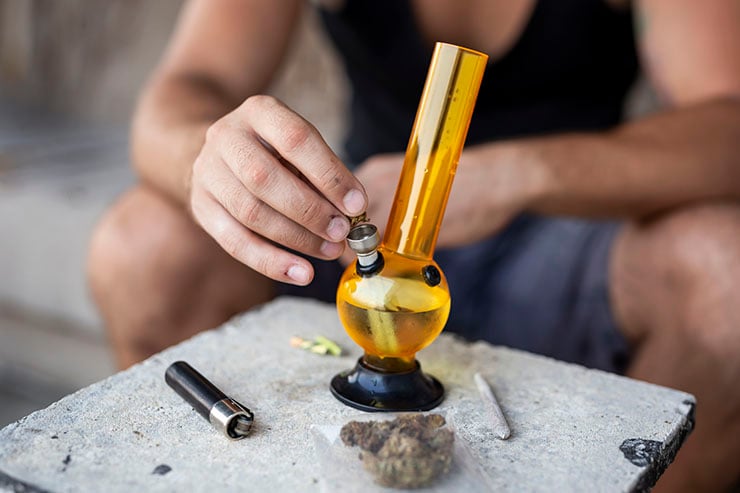Cannabis use among young people in the United States is on the rise. Recent data show a staggering 52 million individuals aged 12 and older have reported using the drug. Since the turn of the 21st century, teen cannabis use has increased by 245 percent.
This trend is particularly concerning in light of a new study published in the journal Psychological Medicine, which found that teens who use cannabis are at an elevenfold higher risk of developing a psychotic disorder compared to those who don’t use the drug. This finding highlights the potential mental health risks associated with cannabis use among adolescents, suggesting the association may be considerably stronger than previously thought.
This study comes as the U.S. Drug Enforcement Administration recently announced it will reclassify cannabis as a less dangerous drug. If the Biden administration implements it as planned in November, this classification change would note the medical applications of cannabis and establish as policy the position that cannabis has a lower potential for abuse than some of the most dangerous drugs in the country.
Cannabis contains numerous chemical compounds called cannabinoids, with tetrahydrocannabinol (THC) most well-known for its psychoactive effects. THC, which interacts with the brain’s endocannabinoid system, is the primary substance responsible for the “high” that users experience. THC affects mood, perception, and various cognitive functions. Another major cannabinoid is cannabidiol (CBD), which is non-psychoactive and often touted for its potential therapeutic benefits, although recent research suggests CBD is at best useless and may be harmful.
In recent decades, the potency of cannabis has increased substantially, particularly in terms of its THC content. Three decades ago, the average THC content in cannabis was around 1 percent. In contrast, modern strains can contain THC levels of up to 20 percent, and some extracts can even exceed 90 percent. This is due to advanced cultivation techniques and selective breeding processes. The potential for more severe and widespread adverse health effects, particularly among young users whose brains are still developing, has prompted concerns among health professionals due to this dramatic increase in potency.
The researchers behind the Psychological Medicine study examined the health records of more than 11,000 youths in Ontario, Canada. Specifically, the records included information relating to emergency department visits, hospitalizations, and outpatient visits. The health service data was obtained from ICES, while the survey data was sourced from the Canadian Community Health Survey (CCHS) cycles from 2009 to 2012.
The sample consisted of Ontario residents aged 12 to 24 who were not institutionalized. To guarantee the precision of their findings, the researchers excluded respondents who had utilized health services for psychotic disorders within the six years preceding their survey interview. This exclusion was designed to mitigate the risk of reverse causation, in which individuals may have initiated cannabis use as a self-medication for pre-existing psychotic symptoms. Respondents were asked whether they had ever used cannabis and, if so, whether they had used it within the past year. The time for the first outpatient visit, emergency department visit, or hospitalization associated with a psychotic disorder were the primary outcomes assessed. In order to isolate the impact of cannabis use on the development of psychotic disorders, the researchers also accounted for a variety of sociodemographic and substance use confounders.
The results were striking.
Compared to non-users, adolescents who reported using cannabis in the previous year were found to be over eleven times more likely to be diagnosed with a psychotic disorder. This elevated risk was not observed in young adults aged 20 to 24, which suggests that adolescence is a particularly vulnerable period for the mental health impacts of cannabis.
The data also indicated that a majority of adolescents diagnosed with a psychotic disorder also had a history of cannabis use. Specifically, 80 percent of teens who were hospitalized or visited an emergency department for a psychotic disorder had previously reported using cannabis. This sobering paper lends credence to the neurodevelopmental theory that the adolescent brain is particularly susceptible to the effects of cannabis, which may disrupt normal brain development and elevate the likelihood of severe mental health complications. To be clear, psychotic disorders are mental health conditions that cause a person to lose touch with reality. Schizophrenia, for example, is one of the more common psychotic disorders among young people. This disorder makes it hard for people to tell what is real and what is not. They might hear voices or see things that aren’t there, believe things that aren’t true, and have trouble thinking clearly or managing their emotions.
Cannabis use disorder—the continued use of the drug despite major negative effects on one’s life—is frighteningly common. The Biden administration seems to overlook the fact that cannabis today is radically more potent than it was in the past. The increased THC content common in today’s cannabis can significantly affect the brain’s normal functioning. Moreover, the link between high THC levels and psychosis is particularly strong in young people.
Given the already significant mental health crisis facing the country, stronger strains of cannabis are likely to exacerbate issues like psychosis and schizophrenia, especially among youth. This is something the Biden administration must acknowledge. The cannabis of today doesn’t just temporarily alter minds; it scrambles them in ways we are only beginning to understand.

Leave a Reply